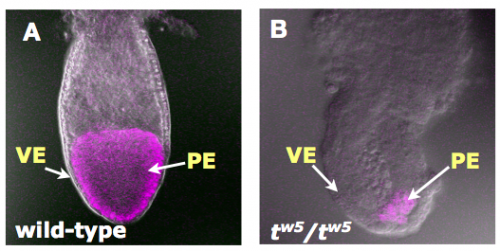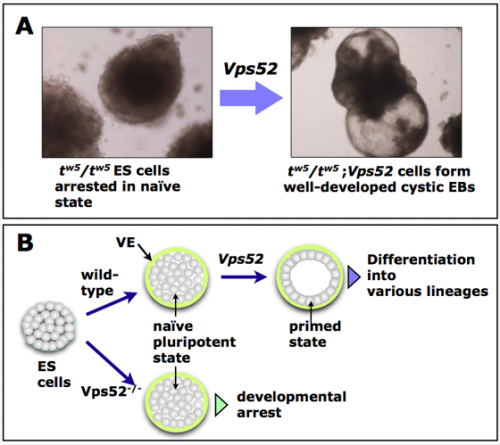Identification of gene that promotes differentiation of pluripotential cells through analysis of classical mouse mutant

Researchers at RIKEN BioResource Center and their colleagues identified a gene required for growth and differentiation of pluripotential cells in the mouse embryos. The gene, Vps52, is a mouse homolog of yeast VPS52 that is thought to be involved in the retrograde endocytic trafficking. The research group found that Vps52 promotes differentiation of pluripotential cells including ES cells via cell-cell interactions, revealing hitherto unknown functions of Vps52 in development of a multicellular organism. The findings, which appear in the journal Cell Reports, should provide clues to the interrelations between endocytic machinery and developmental cell signaling in mammalian embryos, and also contribute to development of technologies that facilitates manipulation of pluripotent stem cells such as ES (embryonic stem) cells and iPS (induced pluripotent stem) cells.
During an early phase of mammalian development, developmental pluripotency is maintained by a particular cell lineage. After implantation, pluripotential cells are converted to primitive ectoderm through cell-cell interactions. This developmental transition is associated with significant changes in transcriptional and epigenetic networks. However, it is largely unknown which factors or genes are important for the postimplantation changes. Mutants displaying specific defects in the relevant processes provide an unbiased entry point for analyses. The tw5 mutation, occurring in the "t haplotype" shows highly specific defects in the primitive ectoderm of pregastrulating embryos, resulting in embryonic death at about 6.5 days after fertilization (embryonic day 6.5) (Figure 1). The t haplotype is a naturally occurring variant form of the mouse chromosome 17 that harbors large inversions that cause crossover suppression between t haplotype and wild-type (WT) chromosomes. As t haplotypes do not recombine with WT chromosomes, abundant genetic reagents and resources developed for analysis of WT chromosome cannot be applied. As a result, the recessive tw5 lethal mutation has not been identified molecularly to date, although the first report on the tw5 mutation was published in 1957. The researchers combined modern genome analysis technologies with BAC (bacterial artificial chromosome) transgenic rescue experiments to identify a candidate gene,Vps52, and confirmed its authenticity.

Vps52 is the mouse homolog of yeast VPS52 gene thought to be involved in the retrograde trafficking. The data strongly suggest that in mammals Vps52 acts in extraembryonic tissues to support the growth and differentiation of primitive ectoderm, and is also required for embryonic vasculogenesis at a later stage of development.
Defects of tw5 null embryos are reconstituted in the embryoid body differentiation system of ES cells (Figure 2A). Upon induction of differentiation, tw5/tw5 ES cells aggregate but cease the development, arrested in a "naïve" pluripotent state. Introduction of the Vps52 transgene rescued the differentiation defect in the tw5/tw5 ES cells, leading to formation of well-developed embryoid bodies. The developmental transition from a naïve to a primed state of pluripotent stem cells (or vice versa) (Figure 2B) is currently under intense investigation in the field of stem cell biology. Vps52 is required for this transition. Thus it should be possible to facilitate this conversion process through the manipulation of Vps52 activity.
More information: Sugimoto, M., Molecular identification of tw5:Vps52 promotes pluripotential cell differentiation through cell-cell interactions. Cell Reports, 2012, doi.10.1016/j.celrep.2012.10.004
Journal information: Cell Reports
Provided by RIKEN















